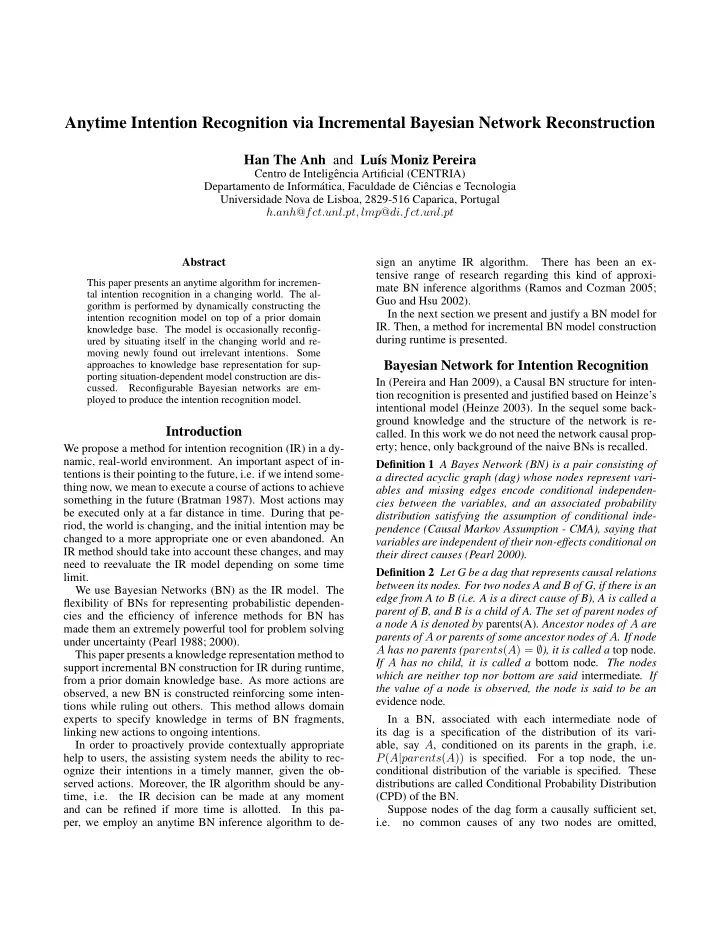

Anytime Intention Recognition via Incremental Bayesian Network Reconstruction Han The Anh and Lu´ ıs Moniz Pereira Centro de Inteligˆ encia Artificial (CENTRIA) Departamento de Inform´ atica, Faculdade de Ciˆ encias e Tecnologia Universidade Nova de Lisboa, 2829-516 Caparica, Portugal h.anh @ fct.unl.pt, lmp @ di.fct.unl.pt Abstract sign an anytime IR algorithm. There has been an ex- tensive range of research regarding this kind of approxi- This paper presents an anytime algorithm for incremen- mate BN inference algorithms (Ramos and Cozman 2005; tal intention recognition in a changing world. The al- Guo and Hsu 2002). gorithm is performed by dynamically constructing the In the next section we present and justify a BN model for intention recognition model on top of a prior domain IR. Then, a method for incremental BN model construction knowledge base. The model is occasionally reconfig- during runtime is presented. ured by situating itself in the changing world and re- moving newly found out irrelevant intentions. Some Bayesian Network for Intention Recognition approaches to knowledge base representation for sup- porting situation-dependent model construction are dis- In (Pereira and Han 2009), a Causal BN structure for inten- cussed. Reconfigurable Bayesian networks are em- tion recognition is presented and justified based on Heinze’s ployed to produce the intention recognition model. intentional model (Heinze 2003). In the sequel some back- ground knowledge and the structure of the network is re- Introduction called. In this work we do not need the network causal prop- erty; hence, only background of the naive BNs is recalled. We propose a method for intention recognition (IR) in a dy- namic, real-world environment. An important aspect of in- Definition 1 A Bayes Network (BN) is a pair consisting of tentions is their pointing to the future, i.e. if we intend some- a directed acyclic graph (dag) whose nodes represent vari- thing now, we mean to execute a course of actions to achieve ables and missing edges encode conditional independen- something in the future (Bratman 1987). Most actions may cies between the variables, and an associated probability be executed only at a far distance in time. During that pe- distribution satisfying the assumption of conditional inde- riod, the world is changing, and the initial intention may be pendence (Causal Markov Assumption - CMA), saying that changed to a more appropriate one or even abandoned. An variables are independent of their non-effects conditional on IR method should take into account these changes, and may their direct causes (Pearl 2000). need to reevaluate the IR model depending on some time Definition 2 Let G be a dag that represents causal relations limit. between its nodes. For two nodes A and B of G, if there is an We use Bayesian Networks (BN) as the IR model. The edge from A to B (i.e. A is a direct cause of B), A is called a flexibility of BNs for representing probabilistic dependen- parent of B, and B is a child of A. The set of parent nodes of cies and the efficiency of inference methods for BN has a node A is denoted by parents(A) . Ancestor nodes of A are made them an extremely powerful tool for problem solving parents of A or parents of some ancestor nodes of A . If node under uncertainty (Pearl 1988; 2000). A has no parents ( parents ( A ) = ∅ ), it is called a top node . This paper presents a knowledge representation method to If A has no child, it is called a bottom node . The nodes support incremental BN construction for IR during runtime, which are neither top nor bottom are said intermediate . If from a prior domain knowledge base. As more actions are the value of a node is observed, the node is said to be an observed, a new BN is constructed reinforcing some inten- evidence node . tions while ruling out others. This method allows domain experts to specify knowledge in terms of BN fragments, In a BN, associated with each intermediate node of linking new actions to ongoing intentions. its dag is a specification of the distribution of its vari- able, say A , conditioned on its parents in the graph, i.e. In order to proactively provide contextually appropriate P ( A | parents ( A )) is specified. help to users, the assisting system needs the ability to rec- For a top node, the un- ognize their intentions in a timely manner, given the ob- conditional distribution of the variable is specified. These served actions. Moreover, the IR algorithm should be any- distributions are called Conditional Probability Distribution time, i.e. the IR decision can be made at any moment (CPD) of the BN. and can be refined if more time is allotted. In this pa- Suppose nodes of the dag form a causally sufficient set, per, we employ an anytime BN inference algorithm to de- i.e. no common causes of any two nodes are omitted,
Recommend
More recommend